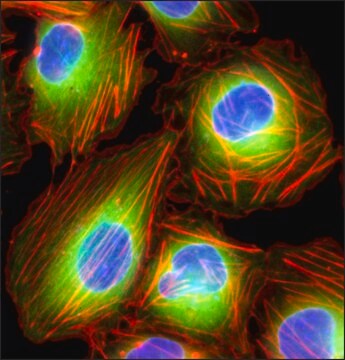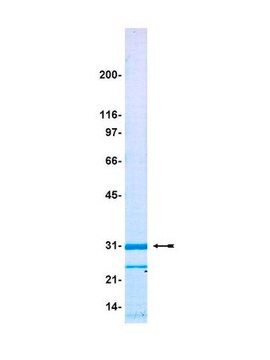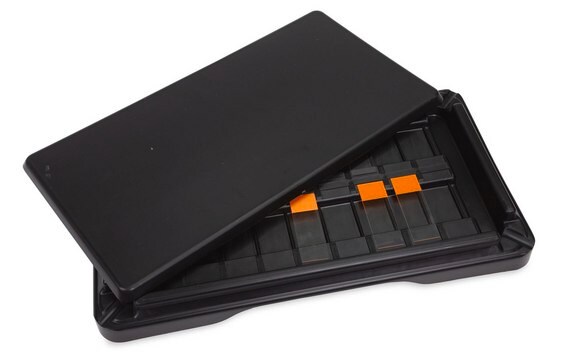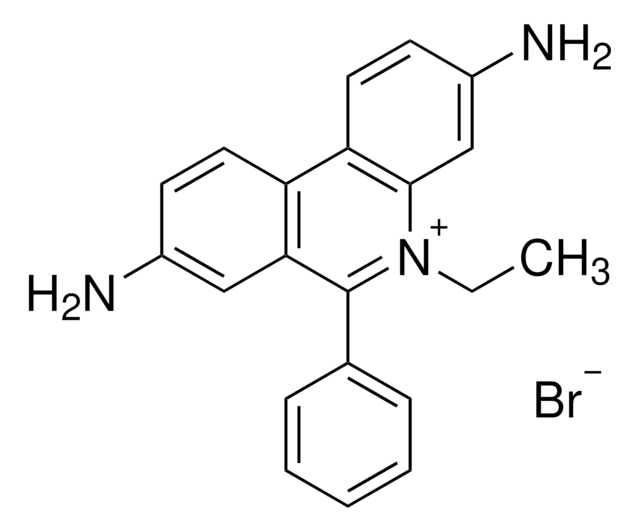CLL1141
A549 Cells GFP-EGFR
human male lung (Source Disease: Lung carcinoma)
Sign Into View Organizational & Contract Pricing
All Photos(3)
About This Item
UNSPSC Code:
41106514
NACRES:
NA.81
Recommended Products
product name
A549 Cells GFP-EGFR,
biological source
human male lung (Source Disease: Lung carcinoma)
OMIM accession no.
storage temp.
−196°C
Gene Information
human ... EGFR(1956) , ERBB1(1956)
General description
A549 GFP-EGFR are lung carcinoma, epithelial cells from a human 58 year old male caucasion having a ZFN modification creating an EGFR-GFP transgene expressed from the endogenous EGFR gene locus.
This cell line was derived from ATCC catalog No. CCL-185.
This cell line was derived from ATCC catalog No. CCL-185.
Glucocorticoid is necessary for A549 cell induction to respond to OSM (oncostatin M), interleukin (IL-6) and fibroblast conditioned medium. The EGFR gene is mapped to human chromosome 7p11.2 and encodes a 170 kDa receptor protein belonging to the HER family of receptor tyrosine kinases. Egfr is localized to epithelial cell surface.
Application
A549 Cells GFP-EGFR is an A549 cell line in which the genomic EGFR gene has been endogenously tagged with a Green Fluorescent Protein gene (GFP) using CompoZr® Zinc Finger Nuclease technology. Integration resulted in endogenous expression of the fusion protein in which GFP is attached to the C-terminus of EGFR. Fluorescence imaging shows characteristic EGFR membrane expression. Upon the addition of EGF, the cell line shows redistribution of EGFR from the cell membrane to endosomes, making it useful for high content screening of compounds. For example, the redistribution can be abolished by a selective inhibitor of EGFR, Tyrphostin AG 1478. This stable cell line was expanded from a single clone. The target′s gene regulation and corresponding protein function are preserved in contrast to cell lines with overexpression via an exogenous promoter.
Features and Benefits
Zinc Finger Nuclease (ZFN)-mediated targeted integration of a fluorescent GFP tag into the last coding exon of the EGFR gene on chromosome 7p11.2 to create a cell line exhibiting stable expression of the transgene tagged with GFP on the C-terminus of the protein.
These A549 cells are adherent with a doubling time of approx. 22 hours.
These A549 cells are adherent with a doubling time of approx. 22 hours.
Quality
Tested for Mycoplasma, sterility, post-freeze viability, short terminal repeat (STR) analysis for cell line identification, cytochrome oxidase I (COI) analysis for cell line species confirmation.
Preparation Note
Media Renewal changes two to three times per week.
Rapidly thaw vial by gentle agitation in 37°C water bath (~2 minutes), keeping vial cap out of the water. Decontaminate with 70% ethanol, add 9 mL culture media and centrifuge 125 x g (5-7 minutes). Resuspend in complete culture media and incubate at 37°C in a 5% CO2 atmosphere.
Subculture Ratio: approx. 1:3-1:6
The base medium for this cell line is RPMI-1640, Cat. No. R0883. To make the complete growth medium, add the following components to the base medium: fetal bovine serum, Cat. No. F2442, to a final concentration (v/v) of 10% and L-glutamine, Cat. No. G7513, at a final concentration of 2 mM.
Cell freezing medium-DMSO 1X, Cat. No. C6164.
Rapidly thaw vial by gentle agitation in 37°C water bath (~2 minutes), keeping vial cap out of the water. Decontaminate with 70% ethanol, add 9 mL culture media and centrifuge 125 x g (5-7 minutes). Resuspend in complete culture media and incubate at 37°C in a 5% CO2 atmosphere.
Subculture Ratio: approx. 1:3-1:6
The base medium for this cell line is RPMI-1640, Cat. No. R0883. To make the complete growth medium, add the following components to the base medium: fetal bovine serum, Cat. No. F2442, to a final concentration (v/v) of 10% and L-glutamine, Cat. No. G7513, at a final concentration of 2 mM.
Cell freezing medium-DMSO 1X, Cat. No. C6164.
Legal Information
CompoZr is a registered trademark of Merck KGaA, Darmstadt, Germany
Disclaimer
RESEARCH USE ONLY. This product is regulated in France when intended to be used for scientific purposes, including for import and export activities (Article L 1211-1 paragraph 2 of the Public Health Code). The purchaser (i.e. enduser) is required to obtain an import authorization from the France Ministry of Research referred in the Article L1245-5-1 II. of Public Health Code. By ordering this product, you are confirming that you have obtained the proper import authorization.
Storage Class Code
10 - Combustible liquids
WGK
WGK 2
Flash Point(F)
192.2 °F - closed cup
Flash Point(C)
89 °C - closed cup
Certificates of Analysis (COA)
Search for Certificates of Analysis (COA) by entering the products Lot/Batch Number. Lot and Batch Numbers can be found on a product’s label following the words ‘Lot’ or ‘Batch’.
Already Own This Product?
Find documentation for the products that you have recently purchased in the Document Library.
Culture of Animal Cells: A Manual of Basic Technique and Specialized Applications (2015)
Cláudia M Botelho et al.
Journal of biophotonics, 11(9), e201700323-e201700323 (2018-03-15)
Epidermal growth factor receptor (EGFR) plays a key role in regulating cell survival, proliferation and migration, and its overexpression and activation has been correlated with cancer progression. Cancer therapies targeting EGFR have been applied in the clinic with some success.
Kenji Tanabe
Scientific reports, 6, 25095-25095 (2016-04-28)
Small-molecule compounds are widely used as biological research tools and therapeutic drugs. Therefore, uncovering novel targets of these compounds should provide insights that are valuable in both basic and clinical studies. I developed a method for image-based compound profiling by
Effect of epidermal growth factor receptor gene polymorphisms on prognosis in glioma patients.
Li B, et al.
Oncotarget, 7(39), 63054-63054 (2016)
Catarina Oliveira Silva et al.
PloS one, 11(10), e0165419-e0165419 (2016-10-28)
The application of functionalized nanocarriers on photothermal therapy for cancer ablation has wide interest. The success of this application depends on the therapeutic efficiency and biocompatibility of the system, but also on the stability and biorecognition of the conjugated protein.
Our team of scientists has experience in all areas of research including Life Science, Material Science, Chemical Synthesis, Chromatography, Analytical and many others.
Contact Technical Service








